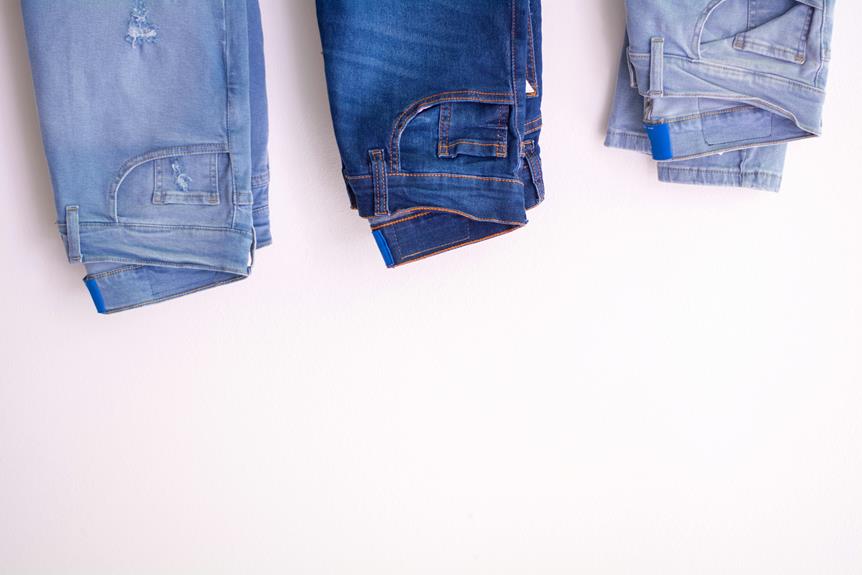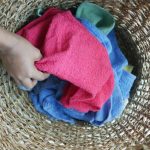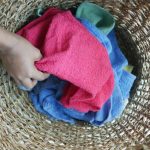When it comes to choosing the right fabric for your next project, you're likely weighing the pros and cons of French terry and waffle knit. Both fabrics have their own unique characteristics, but how do they stack up against each other? You might be surprised to learn that French terry and waffle knit have distinct differences in terms of composition, physical properties, and performance. While French terry is renowned for its softness and warmth, waffle knit boasts exceptional breathability and moisture-wicking abilities. But which fabric is best suited for your needs? The answer depends on the specific application and activity.
Table of Contents
Fabric Composition and Construction
When it comes to understanding the differences between French terry and waffle knit, you're going to want to start by looking at their fabric composition and construction, which refers to the materials used and how they're woven together. French terry is typically made from cotton, polyester, or a blend of both, with a dense weave that creates a soft, absorbent fabric. The loops of yarn on the surface of French terry give it a textured look and feel.
On the other hand, waffle knit is usually made from cotton, polyester, or a blend of both, with a unique weave that creates a grid-like pattern. The waffle knit construction involves interlocking loops of yarn that create a breathable and flexible fabric.
You'll notice that both fabrics have a similar material composition, but the way they're woven together makes all the difference. French terry is often denser and more absorbent, while waffle knit is lighter and more breathable.
Understanding these differences in fabric composition and construction will help you decide which fabric is best suited for your needs. By considering the materials and weave of each fabric, you can make an informed decision about which one to choose.
Softness and Plushness Comparison
When you touch French Terry and Waffle Knit fabrics, you'll immediately notice a difference in their softness and plushness.
You'll notice that French Terry has a smooth surface texture, while Waffle Knit has a more textured, grid-like surface.
As you explore these differences, you'll want to consider how the unique surfaces and pile heights of each fabric contribute to their overall softness and plushness.
Surface Texture Comparison
As you run your hand over French Terry and Waffle Knit fabrics, you'll notice distinct differences in their surface textures, with one boasting a softer, more plush pile and the other featuring a more textured, grid-like pattern. The softness and plushness of French Terry make it a joy to touch, with a gentle give that's perfect for next-to-skin wear. In contrast, Waffle Knit's textured surface provides a unique tactile experience, with its grid-like pattern creating a subtle ridge-and-furrow effect.
| Fabric Type | Surface Texture |
|---|---|
| French Terry | Soft, plush pile with a gentle give |
| Waffle Knit | Textured, grid-like pattern with subtle ridges |
| French Terry | Smooth, even surface with minimal texture |
| Waffle Knit | Raised loops and valleys create a dynamic surface |
When choosing between French Terry and Waffle Knit, consider the type of garment you want to create and the level of texture you desire. If you want a soft, cozy fabric for loungewear or activewear, French Terry may be the better choice. For a more visually interesting fabric with a unique texture, Waffle Knit is a great option.
Pile Height Differences
The pile height of French Terry and Waffle Knit fabrics significantly impacts their softness and plushness.
French Terry generally features a higher pile that traps warmth and provides a cozier feel. This means that when you touch French Terry, you'll likely notice a deeper, more luxurious texture that's perfect for loungewear or cold-weather clothing.
In contrast, Waffle Knit fabrics tend to have a lower pile height, which can make them feel slightly less soft and plush.
The lower pile height of Waffle Knit fabrics also makes them more breathable and moisture-wicking, which can be beneficial for activewear or warm-weather clothing. When you wear Waffle Knit, you'll likely notice that it drapes more smoothly against your skin and allows for better airflow.
Ultimately, the choice between French Terry and Waffle Knit comes down to your personal preferences and needs. If you prioritize softness and warmth, French Terry might be the better choice. But if you need a fabric that's breathable and moisture-wicking, Waffle Knit could be the way to go.
Absorbency and Moisture Wicking
When it comes to absorbency and moisture wicking, you'll want to consider how quickly your fabric of choice dries, how much moisture it retains, and how well it breathes.
You're likely wondering which fabric performs better in these areas – French terry or waffle knit.
Let's examine the key differences in drying time, moisture retention levels, and breathability performance to help you decide.
Drying Time Comparison
Wearing French terry and waffle knit fabrics, you'll notice a difference in how they handle sweat, but which one dries faster and pulls moisture away from your skin more efficiently? When it comes to drying time, both fabrics have their strengths and weaknesses.
| Fabric Type | Drying Time | Moisture Wicking Ability |
|---|---|---|
| French Terry | Medium | High |
| Waffle Knit | Fast | Medium |
| Cotton | Slow | Low |
| Polyester | Fast | High |
| Bamboo | Medium | High |
As you can see from the table, waffle knit fabrics generally dry faster than French terry. This is due to the unique texture of waffle knit, which allows for better airflow and moisture transfer. French terry, on the other hand, has a softer and more absorbent texture, which can make it take a bit longer to dry. However, French terry is still a great choice for activewear because of its high moisture-wicking ability, which helps to keep you dry and comfortable. Ultimately, the choice between French terry and waffle knit comes down to your personal preferences and needs.
Moisture Retention Levels
Considering your needs for activewear, it's essential to understand how French terry and waffle knit fabrics retain moisture, as this affects their performance and your overall comfort during exercise.
When it comes to moisture retention levels, French terry fabrics tend to absorb more moisture than waffle knit fabrics. This is because French terry has a denser weave and a plush pile that traps moisture, making it more absorbent.
On the other hand, waffle knit fabrics have a more open weave and a textured surface that allows for better moisture wicking properties.
In terms of moisture wicking, waffle knit fabrics are generally better at drawing sweat away from your skin and evaporating it quickly. This is especially important during high-intensity workouts where you're likely to sweat heavily.
French terry fabrics, while absorbent, can sometimes feel clammy and heavy when wet. If you prioritize moisture wicking performance, waffle knit fabrics might be a better choice. However, if you prefer a fabric that can absorb sweat without feeling too clingy, French terry might be the way to go.
Ultimately, it comes down to your personal preferences and workout needs.
Breathability Performance
Your choice between French terry and waffle knit fabrics also depends on how well each breathes, as this directly impacts their absorbency and moisture-wicking abilities, building on our understanding of their moisture retention levels. When it comes to breathability performance, you'll want to consider how each fabric handles airflow and moisture transfer.
Waffle knit excels in this area.
- Air pockets for airflow: Waffle knit's unique texture creates air pockets that allow for excellent airflow, making it a great choice for activewear or warm-weather clothing.
- Moisture-wicking abilities: The fabric's ability to transfer moisture away from the skin makes it ideal for high-intensity activities or for people who tend to sweat a lot.
In contrast, French terry's denser weave can make it less breathable than waffle knit. However, it's still a great choice for casual, everyday wear or for activities that don't require high moisture-wicking abilities.
Insulation and Thermal Properties
When it comes to insulation and thermal properties, French Terry and Waffle Knit fabrics have distinct differences that can significantly impact how warm or cool you'll stay in varying temperatures.
French Terry, with its soft, plush pile on one side and a smooth surface on the other, traps warm air close to your skin, providing excellent insulation in cold weather. This makes it ideal for garments like sweatshirts, hoodies, and sweatpants.
In contrast, Waffle Knit fabric has a more open weave and a textured surface, which allows for better airflow and moisture wicking. This makes it suitable for milder temperatures or activities where you'll be sweating, like hiking or biking. However, it won't keep you as warm as French Terry in freezing conditions.
On the other hand, Waffle Knit will help keep you cooler in warmer temperatures due to its breathability. When choosing between French Terry and Waffle Knit, consider the activity and climate you'll be in to determine which fabric will provide the best thermal properties for your needs.
Durability and Longevity Factors
French Terry and Waffle Knit fabrics exhibit distinct differences in terms of durability and longevity, with each having its strong points that can affect how well your garments withstand wear and tear. When choosing between the two, you'll want to consider factors like fabric density, weave, and fiber content.
- Fabric density: Waffle Knit fabrics tend to be denser than French Terry, which can make them more resistant to pilling and snagging.
- Weave: The waffle weave construction can provide added strength and stability, while French Terry's looped pile can be more prone to snagging.
Ultimately, the durability and longevity of your garment will depend on a combination of these factors, as well as how well you care for it. By understanding the strengths and weaknesses of each fabric, you can make an informed decision about which one is best for your needs.
Aesthetic and Texture Differences
Two fabrics with distinct visual identities, Waffle Knit and French Terry offer varying aesthetic and texture profiles that can significantly impact the overall look and feel of your garments.
When you look at Waffle Knit, you'll notice a textured, grid-like pattern with a subtle sheen. This fabric's unique weave creates a dimensional appearance that adds visual interest to your clothing.
In contrast, French Terry has a more subtle, smooth texture with a soft, plush pile on one side. The other side has a more traditional knit texture, giving you options for how you want to showcase the fabric.
You'll also notice differences in how these fabrics drape and move. Waffle Knit has a bit of stiffness to it, which can create a more structured silhouette. French Terry, on the other hand, is generally more fluid and flexible, making it ideal for garments that require a bit of stretch.
When you're choosing between these fabrics, consider the overall aesthetic you want to achieve. Do you want a bold, textured look or a softer, more relaxed appearance? Your choice of fabric will play a significant role in determining the final look and feel of your garments.
Best Uses and Applications
Choosing the Right Fabric
When deciding between Waffle Knit and French Terry, consider the type of garment you're making and the desired level of comfort and durability.
French Terry
French Terry is ideal for making sweatpants, hoodies, and other loungewear where a soft, absorbent fabric is desired.
It's also great for baby blankets and other home textiles where a plush pile is wanted.
Additionally, French Terry can be used for making towels and other bathroom accessories.
Waffle Knit
Waffle Knit is perfect for creating breathable, moisture-wicking activewear like running tops and leggings.
It's also suitable for making blankets and throws where a lightweight, airy texture is desired.
Waffle Knit can also be used for crafting hats and scarves where a bit of texture and visual interest is wanted.
Making the Final Decision
Ultimately, the choice between French Terry and Waffle Knit comes down to the specific needs of your project.
Frequently Asked Questions
Can French Terry Be Used for Outdoor Gear?
You can use French terry for outdoor gear, but it's not the best choice. It's a bit too dense and heavy for activities that require breathability and moisture-wicking properties, but it's great for casual, low-intensity outdoor wear.
Is Waffle Knit Fabric Suitable for Summer Clothing?
You're considering waffle knit for summer clothing, but it might not be the best choice. Waffle knit is a thick, textured fabric that can trap heat, making it more suitable for cooler weather or layering pieces.
How Do I Care for French Terry Fabric?
You'll want to wash French terry fabric in cold water and dry it on a low heat setting to prevent shrinkage. Avoid using bleach or ironing it, as it can damage the fabric's texture and quality.
Can I Use French Terry for Dressy Occasions?
You can definitely dress up French Terry for special occasions. Look for high-quality, dense weaves and pair them with elegant accessories to elevate the fabric's casual vibe. You'll create a stylish, unique outfit that's perfect for dressing up or down.
Is Waffle Knit Fabric Prone to Pilling?
You'll find that waffle knit fabric can be prone to pilling, especially if it's made from a lower-quality yarn or blend. However, higher-end waffle knit fabrics tend to be more durable and less prone to pilling over time.
- How Does Ring Spun Cotton Affect Garment Fit and Shape Retention? - August 13, 2024
- What Are the Challenges in Producing Ring Spun Cotton? - August 13, 2024
- Is Ring Spun Cotton Suitable for Plus-Size Clothing? - August 13, 2024







